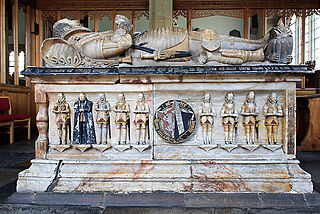Related Research Articles

Earl Waldegrave is a title in the Peerage of Great Britain. It was created in 1729 for James Waldegrave, 2nd Baron Waldegrave.

There have been three baronies created for the Gerard family who resided historically at Bryn, Ashton-in-Makerfield, Lancashire and Kingsley, Cheshire, in the 13th century. The third and current barony was created in 1876.

Earl of Egremont was a title in the Peerage of Great Britain. It was created in 1749, along with the subsidiary title Baron of Cockermouth, in the County of Cumberland, for Algernon Seymour, 7th Duke of Somerset, with remainder to his nephews Sir Charles Wyndham, 4th Baronet, of Orchard Wyndham, and Percy Wyndham-O'Brien. The Duke had previously inherited the Percy estates, including the lands of Egremont in Cumberland, from his mother Lady Elizabeth Percy, daughter and heiress of Joceline Percy, 11th Earl of Northumberland. In 1750 Sir Charles Wyndham succeeded according to the special remainder as second Earl of Egremont on the death of his uncle. His younger brother Percy Wyndham-O'Brien was created Earl of Thomond in 1756.
William Alington, 1st Baron Alington of Killard was an Irish peer, the son of Sir Giles Alington. He was created 1st Baron Alington of Killard, on 28 July 1642.
There have been four baronetcies created for persons with the surname Andrews, two in the Baronetage of England, one in the Baronetage of Great Britain and one in the Baronetage of the United Kingdom. All four creations are extinct.

There have been four baronetcies created for persons with the surname Hope, three in the Baronetage of Nova Scotia and one in the Baronetage of the United Kingdom. As of 2010 one creation is extant, one dormant and two extinct.
There have been five baronetcies created for persons with the surname Ward, one in the Baronetage of England, one in the Baronetage of Ireland and three in the Baronetage of the United Kingdom. See also Warde baronets.
There have been six baronetcies created for persons with the surname Thomas, three in the Baronetage of England, one in the Baronetage of Great Britain and two in the Baronetage of the United Kingdom. Two of the creations are extant as of 2016.

There have been two baronetcies created for members of the Salusbury family, the first in the Baronetage of England and the second in the Baronetage of Great Britain. Neither title has survived to the present day although the senior baronetcy is technically considered to be dormant.
The Wyvill Baronetcy, of Constable Burton in the County of York, was a title in the Baronetage of England. It was created on 25 November 1611 Marmaduke Wyvill, the former Member of Parliament for Richmond. The fifth and sixth Baronets also represented Richmond in the House of Commons. The title became dormant on the death of the seventh Baronet in 1774.
The Osbaldeston Baronetcy, of Chadlington in the County of Oxford, was a title in the Baronetage of England. It was created on 25 1664 for Littleton Osbaldeston, subsequently Member of Parliament for Woodstock. The title became extinct on the death of the fifth Baronet in 1749.
The Murray, later Hepburn-Murray Baronetcy, of Glendoich in the County of Perth, was a title in the Baronetage of Nova Scotia. It was created on 2 July 1676 for Thomas Murray. The third Baronet assumed the additional surname of Hepburn in circa 1703. The title became extinct on the death of the fifth Baronet in circa 1774.
The Hewet Baronetcy, of Headley Hall in the County of York, was a title in the Baronetage of England. It was created on 11 October 1621 for John Hewet. The title became extinct on the death of the eighth Baronet in 1822.
The Hurly Baronetcy, of Knocklong in County Limerick, was a title in the Baronetage of Ireland. It was created circa 1645 for Thomas Hurly. The 3rd Baronet was attainted in 1691 for his part in the Williamite War in Ireland, and the baronetcy was forfeited.
There have been six baronetcies created for persons with the surname Wright, three in the Baronetage of England, two in the Baronetage of Great Britain and one in the Baronetage of the United Kingdom. All creations are extinct.
The Richards Baronetcy, of Brambletye House in the County of Suffolk, was a title in the Baronetage of England. It was created on 22 February 1684 for Sir James Richards. The second Baronet was a colonel in the Spanish Army and a merchant in Cadiz, Spain. The fourth Baronet was also an officer in the Spanish army. Nothing further is known of him or his possible descendants. The title became either extinct or dormant on his death some time after 1741.
Sir Giles Estcourt, 1st Baronet was an English politician who sat in the House of Commons from 1628 to 1629. He fought for the Royalist cause in the English Civil War.

Henry St John, 1st Viscount St John, of Lydiard Tregoze, Wiltshire; Battersea, Surrey; and Berkeley Street, Westminster, Middlesex, was an English politician. In 1685 he was pardoned for a murder.
Estcourt is a surname. Notable people with the name include:
Events from the year 1684 in the Kingdom of Scotland.